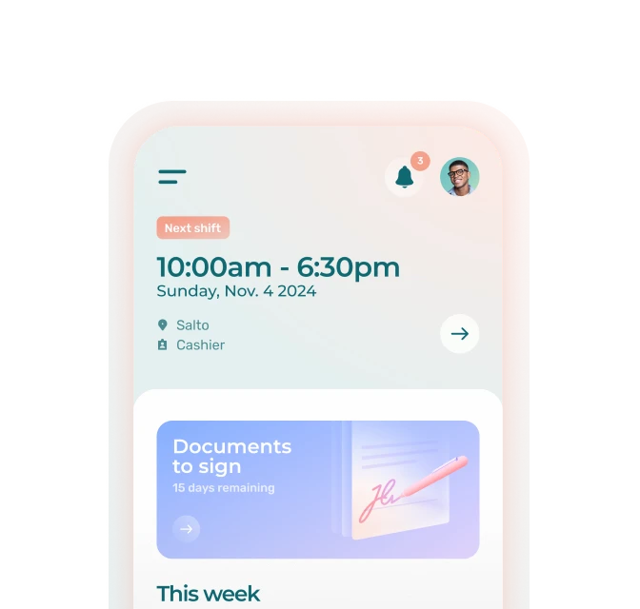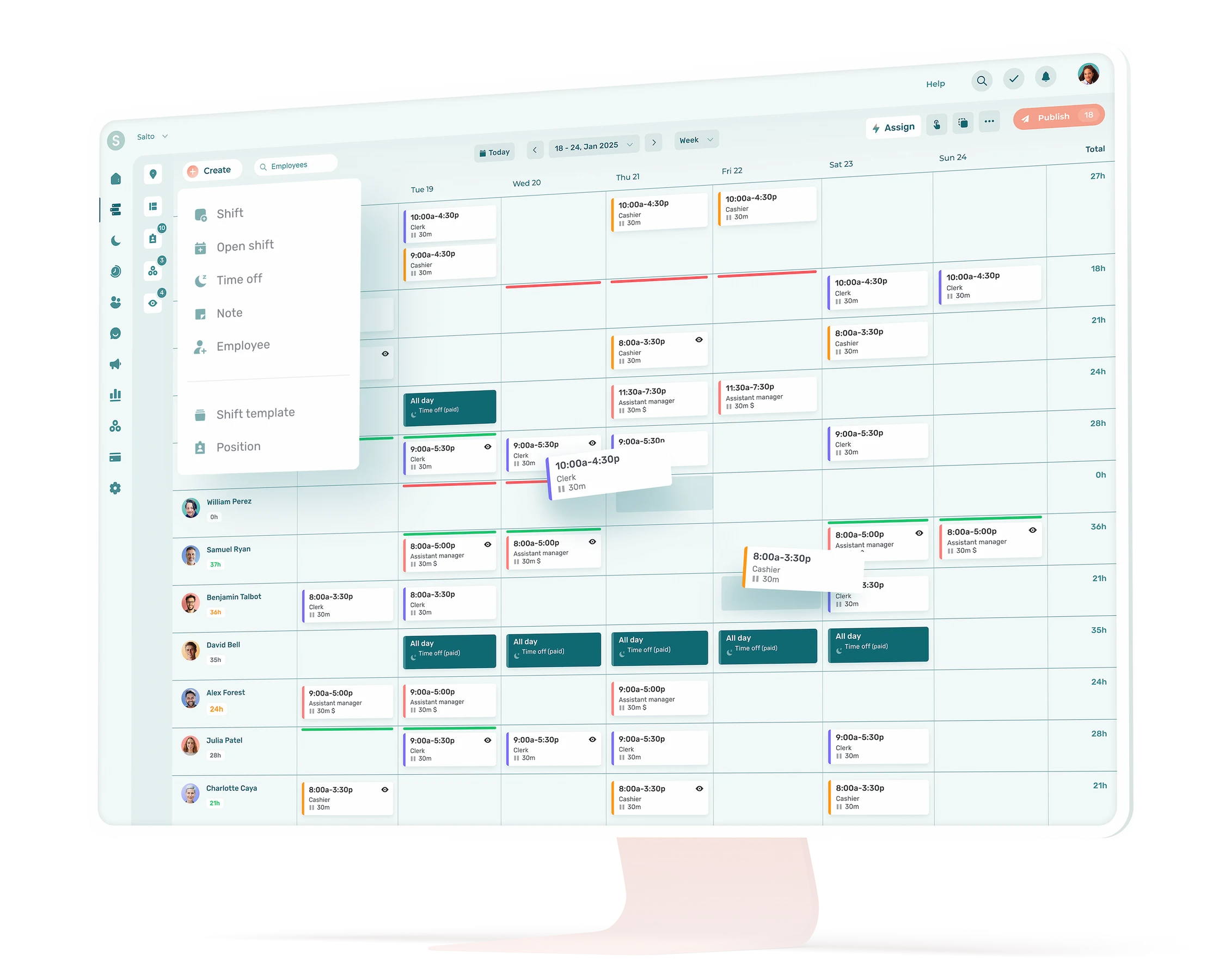All businesses need to schedule staff properly to ensure smooth operations. But optimizing employee scheduling can be tough, especially without the right tools and knowledge.
Many businesses struggle with the same employee scheduling problems. See what they are and how you can solve them.
What Makes Employee Scheduling So Difficult?
Staff scheduling can be complicated for many, many reasons.
Most managers have to factor in countless variables when scheduling employees. Some of the variables that can cause employee scheduling problems include:
- Extended or 24/7 business hours
- A variety of work schedules within the same organization: shift work, flexible hours, rotating shifts, split-shifts, job sharing, part-time hours, etc.
- Employees working at more than one location
- Business constraints like specific skill sets that need to be on the floor during each shift, minimum and maximum number of employees for all scheduled shifts, thresholds for working overtime hours for specific jobs due to business or legal requirements, etc.
- Target labor costs for a given period of time
- Employee absences whether planned (vacations) or unplanned (no-shows)
- Fluctuations In customer traffic, whether predictable and cyclical, or unpredictable and erratic
Most Common Employee Scheduling Problems & Effective Solutions
Here are 6 of the most common scheduling issues managers run into, and how you can solve them:
1. Employee Shortages
Many businesses today are feeling the pain of not having enough employees on staff—thanks in large part to the ongoing chronic labor shortage—a.k.a. The Great Resignation.
In customer-service centric industries like retail, hospitality, restaurants, but also in healthcare and home care, businesses are having an increasingly hard time attracting and retaining qualified workers.
Added to this is the recent trend of quiet quitting, which has made salaried workers in industries such as offices and cities and municipalities less inclined to do more than the bare minimum of what’s expected of them.
Why Businesses Need to Solve Employee Shortages
Businesses can sometimes operate in a somewhat normal way even when they don’t have enough staff. But it’s a risky game based on a number of assumptions, such as:
- Expecting that customer traffic won’t drastically or suddenly increase.
- Forecasting business operations that continue as smoothly as usual.
- Thinking current staff will continue to have the same availability (not get sick, get burned out, not be lured by better pay or work conditions at a competitor, etc.).
There are many potential negative effects of being short-staffed. Here are just four:
- Higher stress levels for workers.
- HIgher staff turnover.
- Higher risk of employee accidents.
- Higher numbers of customer complaints.
How to Solve Employee Shortage
The solution is simple if you want to make your valued employees happy and meet business performance targets: hire more people.
All businesses should have a minimum employee buffer to account for spikes in customer traffic, unplanned employee sick days, mental health days, parental leave, etc.
That way, you won’t be putting customer service, and your staff’s well-being at risk.
Having a hard time hiring new staff despite your best efforts? Read our Ultimate Hiring Guide.
2. Overscheduling Employees
Another common mistake managers make is assuming both salaried and hourly workers are willing to work as many hours as they are.
A sign you’re overscheduling employees?
Workers often:
- Have to do the clopening shift
- Rack up overtime hours on a regular basis
- Demonstrate loss of employee motivation or engagement
- Show indifference to how they serve customers
- Receive complaints from co-workers, suppliers and customers
- Call in sick frequently
- Make more mistakes and have more workplace accidents
- Disregard safety regulations and other company rules
- Take excessively long breaks and lunch times
- Cut corners in their work
- Complain about their workload
Why Businesses Need to Avoid Overscheduling Employees
The above points are all good reasons to stop overscheduling employees. But it’s worth looking at a few of them more closely.
1. Lost Productivity
The more overtime hours employees work, the less effective they become at their job. It’s called the law of diminishing returns:
“…Studies have found that when high levels of overtime begin, marginal productivity slows. In other words, the total output increases, but the hourly productivity is lower than it was during the first 40 hours.
After a few months of high overtime, however, total output may be little more than that attainable in a 40-hour week. This is believed to be caused by a combination of fatigue, poor morale, increased absences, work pace inertia, and rework due to mistakes and defects.”
The takeaway from the above report is that overtime may be tolerable and acceptable for some employees in the short term, but will be detrimental to both the employee and the business in the long run.
2. Low Job Satisfaction
Nearly 70% of workers now say they’d take better work-life balance over higher pay.
Overscheduled workers rarely have a good work-life balance. That’s sure to lead to unmotivated and disgruntled employees.
Workers who are regularly overscheduled will have lower job satisfaction and will be less engaged with the business.
In turn, this will negatively impact the customer service they provide, putting your business reputation at risk.
3. Higher Risk of Employee Accidents
According to the National Safety Council, injury rates are highest when workers get less than seven hours of sleep a day or work more than 40 hours a week.
Overscheduling employees can put your staff, your customers and your business at risk. Accidents due to employee fatigue can be fatal in some industries, like healthcare, construction and emergency services.
How to Avoid Employee Overscheduling
Here are a few things you can do if you find yourself constantly overscheduling the same employees:
1. Hire more employees. Employee overscheduling is a common symptom of a worker shortage, as seen above.
2. Ask employees for their work preferences. Certain employees may only really want to work the first shift; others the last shift.
Asking employees about shift preferences will also make it easier to see exactly how many team members you really need to simultaneously meet business needs and employee expectations.
While you’re at it, look for ways to make it easy for employees to swap shifts and submit time off requests. A good employee scheduling software will make it easier to accommodate time off requests of team members, which will certainly make your employees happy.
3. Improve employee training. Increasing the qualifications of existing staff will give you more flexibility over which shifts or tasks they can be assigned. Furthermore, professional development is a great way to help boost employee retention.
4. Improve staff scheduling practices. A good staff scheduling software will ensure worker hours are optimized for both your staff and your business needs, based on whatever criteria and constraints you need to work with. For example, the software will flag you if employees exceed your set threshold for overtime or desired work hours.
3. Inefficient Employee Scheduling Process
Managers often wear many hats, so it’s normal for them to want to minimize the amount of time they have to spend on administrative tasks such as creating an accurate employee work schedule.
Ironically, some managers are still using Excel or even pen and paper to manage this time-consuming and repetitive task.
“Automating monotonous and repetitive tasks gives you and your team that chance to focus on other duties in need of your undivided attention. Business automation is also a tool you can leverage to scale your company and promote growth.”
Why Businesses Need to Be More Efficient at Employee Scheduling
In an ideal world, managers and employees would enjoy a consistent schedule that never changed. It doesn’t work that way in the real world, unfortunately. Especially in industries with a lot of part-time workers, like restaurants and retail.
Business owners and managers constantly need to adapt staff schedules to account for:
- Fluctuations in customer traffic.
- Employee availability, planned absences and last-minute no-shows.
- Employing onboarding and training.
- Parental and sick leave.
- Last-minute shift swaps.
- Staffing budgets.
Managers also need to ensure last minute shift changes are communicated to staff in a timely manner. Otherwise, some team members may not even realize they are scheduled for certain upcoming shifts.
Every extra minute a manager spends on employee scheduling means one less minute devoted to business-growth tasks, such as employee training and boosting team morale, customer service, promotion and advertising, etc.
How to Make Employee Scheduling More Efficient
For schedulers still using work schedule templates or loyal to manual scheduling, employee scheduling software will be a game-changer.
You can find easy-to-use online staff scheduling and timesheet software that simplifies everything from scheduling to time & attendance tracking to payroll. Some also offer multiple ways to clock.
Some employee scheduling software even includes centralized and open communication with staff so that team members are automatically notified of scheduling changes, and managers can see whether or not workers read the notification or not.
Improve workforce management: Agendrix employee scheduling software makes everything from scheduling to payroll quick, easy and error-free. Try it free.
4. Employee Last-Minute Absences
Last-minute employee absences can throw any work schedule into chaos. There are many valid reasons why employees may call in absent from work at the last moment:
- They woke up feeling sick.
- Their babysitter suddenly canceled.
- They have a medical emergency.
- They got into a car accident or got stuck in traffic.
These are just a few of the many unforeseeable reasons for employee absences that are beyond any manager’s control.
Other reasons for absenteeism, however, are well within a business owner’s ability to address:
- Low employee morale.
- Burnt-out and overworked employees.
- Poor employee experience.
- Lack of employee recognition.
- Poor employee scheduling with disregard to staff availability.
- Unfair scheduling.
Why Businesses Need to Manage Employee Last-Minute Absences
According to the Circadian report Absenteeism: The Bottom-Line Killer, unscheduled absenteeism costs roughly $3,600 per year for each hourly worker. 💸
Employee absenteeism isn’t just costly. When employees frequently call in absent from work at the last minute, it creates all sorts of negative impacts on the business:
- Undue stress and work for the manager and co-workers.
- Drop in customer service quality.
- Poor employee morale.
- Disrupted business operations.
How to Manage Employee Last-Minute Absences
Some managers think that last-minute absences are a common employee scheduling issue that can’t be fixed. On the contrary.
1. Establish employee unavailability. As a busy business owner whose own time is stretched thin, you have little to gain from scheduling employees for shifts they are unable or unwilling to work.
Ask employees to regularly fill out an employee availability form. It will make the time-consuming task of scheduling a lot simpler.
2. Have a backup plan. Option A: Ask employees already on the job if they would like to stay and work a double shift.
You can try suggesting that they switch their days off, or you might need to offer an incentive such as offering them shorter shifts for the remainder of the week, or overtime pay.
Option B: Start contacting other staff members—whether by phone, texting them on their mobile devices or private message on your employee internal communications platform.
3. Get to the root of employee absenteeism. Is it just one employee frequently calling in absent from work at the last minute, or is absenteeism a problem for several members of your staff?
If just one employee is frequently calling in absent from work last-minute: sit down with them and calmly discuss the matter to find out what the problem is.
If several employees are frequently calling in absent from work at the last minute: it could be a sign of a more systematic business-wide problem. This might be a good time to re-examine the entire employee experience.
Look to see if you need to improve your:
- Employee recruiting and hiring processes.
- Employee onboarding and training process.
- Employee management practices.
- Employee compensation and rewards programs.
- Employee vacation and benefits package.
- Employee scheduling practices.
- Employee attendance policy.
5. Employee Turnover
Staff turnover is a normal part of business, especially in industries that hire a lot of part-time workers, like catering and restaurants & bars.
Some industries have higher turnover rates than others, and that’s normal as well.
However, worker turnover rates have continued to rise nearly across the board since the onset of the global pandemic.
According to research from the Work Institute, “Talent turnover and scarcity will remain a risk for companies—Voluntary turnover is expected to reach 35% in 2023.”
That’s the expected general trend. The actual employee turnover rate for 2023 may vary widely by industry, particularly for employees most impacted by Covid burnout, such as healthcare workers.
Calculate your employee turnover rate.
Why Businesses Need to Fix High Employee Turnover
1. High employee turnover is costly.
According to peoplekeep.com, the average cost of replacing an hourly employee is $1,500.
2. High employee turnover is a drain on time and resources.
Staff quitting means managers and HR have to spend more time on:
- Employee recruiting and hiring .
- Onboarding new team members and training.
- Employee management.
- Employee scheduling.
3. High employee turnover can destroy team morale.
This can trigger a “domino effect” causing team productivity and business performance to plummet dramatically. See why your employees may be leaving your company.
How to Fix a High Employee Turnover Rate
Start by benchmarking your turnover rate against the current average employee turnover rate for your industry. This will let you know how much work you need to do.
This might include:
- Improving the onboarding experience.
- Improving the employee experience.
- Giving employees better benefits.
- Providing more training to managers.
See our tips on how to lower your staff turnover rate.
6. Lack of Control or Oversight Over Employee Schedules
A lack of scheduling oversight or control can lead to confusion and even disrupt normal business operations.
Creating a good schedule can mean a smooth day of great customer service and a chaotic mess of frustrated customers who promise to never come back.
Or it could mean having too many employees on shift, increasing your staffing costs unnecessarily.
Why Businesses Need Better Oversight Over Employee Schedules
Without the right scheduling tools, it can be difficult for scheduling managers to know at a glance:
- Have all employees seen the published work schedule?
- Have all employees agreed to their schedule?
- Does the schedule have any conflicts?
- Does the schedule optimize skill sets and/or staffing budget for each shift, based on the anticipated tasks and customer traffic?
- Does the schedule ensure newly onboarded employees have a mentor working alongside them?
- Does the schedule take into account employee shift preferences, vacation dates and time off requests?
- Does the schedule tell which employees are willing and available to come in at the last minute, if a scheduled employee doesn’t show up for their shift? Are these employees qualified to replace?
- Does the schedule tell which employees would be happy to go home early if the shift isn’t as busy as expected? Or happy to go to another location if an extra set of hands is needed there?
How to Improve Oversight Over Employee Schedules
1. Set clear scheduling policies and procedures.
- How far in advance schedules need to be published: what are the rules regarding last-minute scheduling?
- How schedules should be communicated to employees
- What are the rules for swapping shifts?
- What employees should do (call or text) if: they have a problem with the schedule, will be arriving late for their shift or they need someone to cover their shift last-minute?
2. Invest in employee scheduling software.
With an employee scheduling app like Agendrix, managers and schedulers get full oversight over the entire scheduling process.
- Easily create schedules and know if there are any scheduling conflicts.
- Set parameters to allow employees to claim open shifts, or request and accept shift swaps, and if they are qualified.
- Set parameters for overtime hours, total labor costs, and skill sets.
- Send real-time notifications for any scheduling changes.
How Automation Can Help With Efficient Employee Scheduling
Employee scheduling software has been around for a long time, and is used by businesses of all sizes of all industries.
That’s because the benefits of automated employee scheduling tools are many:
- It centralizes employee records.
- It makes the employee scheduling process more efficient.
- It optimizes staffing costs.
- It facilitates time & attendance tracking.
- It offers employees multiple ways to clock in and out for their shifts (such as on their mobile device).
- It ensures compliance with company constraints.
- It ensures important tasks and skill sets are aligned.
- It shows respect for employee availability and shift preferences (certain team members may prefer to work night shifts; others, like college students, might want to pick up extra shifts during the summer, part-time employees might be willing to pick up open shifts during the week at a moment’s notice).
- It streamlines schedule sharing.
- It facilitates shift swapping.
- It sends alert notifications for scheduling conflicts, maximum thresholds for overtime shifts, employee no-shows, etc.
There are even easy solutions that small businesses can use to improve their workforce management.
Conclusion
Businesses of all sizes benefit greatly when they automate their most repetitive and time consuming tasks. The employee scheduling process is definitely one of them.
When exploring your options for an employee scheduling app, look for a solution that meets your current and future needs in terms of:
- Cost
- Flexibility
- User-friendliness
- Features
- Expandability
- Support
- Training
- Rollout time
- Data security
Simplifying employee scheduling can be a real-game changer for business performance. There’s a reason why all businesses that automate employee scheduling never look back.
Why Is Employee Scheduling So Difficult?
Most common scheduling challenges are created by the many variables managers need to take into account when creating staff schedules. Employee scheduling software eliminates this complexity by letting managers input any number of constraints and variables to automatically generate optimized work schedules with minimal effort.
What Are Two Common Mistakes When Scheduling?
Overscheduling employees and not optimizing work schedules are the two biggest mistakes businesses make when scheduling staff. Both can have a significant and immediate negative impact on the business’ bottom line.
How Do You Address Scheduling Issues?
The first step in addressing employee scheduling issues is to identify which issues are negatively affecting your business. You can then prioritize the issues to tackle first and what resources will be required.
Many businesses are able to resolve multiple scheduling issues by improving their employee onboarding and by adopting automated employee scheduling software.










